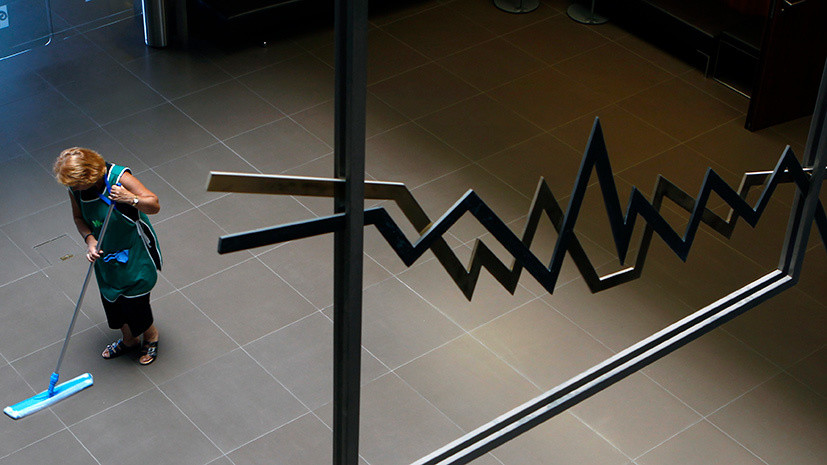On Wednesday, March 11, world oil prices are falling after recovery on the eve. This is evidenced by trading data. In the middle of the day, the raw materials of the Brent benchmark on the ICE exchange in London fell by 3.5% to $ 36 per barrel, and the cost of the American WTI grade fell by 3.4% to $ 33.2.
Note that even at the auction on Tuesday, March 10, quotes Brent and WTI rose on average by 10%. Prices tried to recover after a massive collapse at the beginning of the week.
“On Tuesday, the expected rebound in prices occurred, and Brent quotes found a balance near the mark of $ 36-37 per barrel. At the same time, there is no reason to wait for a quick stabilization of the situation in the commodity market, therefore significant price fluctuations will continue in the near future, ”said Oleksandr Avtomonova, operations director of Rocketbank, in an interview with RT.
Recall, on March 9, the cost of a barrel of Brent and WTI fell by almost a third - to $ 31 and $ 27 per barrel, respectively. The drop in prices has become the largest since 1991.
As noted by Avtonomova, a record reduction in price occurred after the failure of negotiations on the OPEC + deal. Amid falling global oil demand due to the coronavirus, participants, including Russia, tried to coordinate an additional reduction in crude production in order to stabilize the market situation. Meanwhile, on Friday, March 6, following the results of the meeting, the parties did not reach consensus and decided to completely abandon all obligations undertaken earlier.
“The Russian side suggested extending the agreement on existing conditions at least until the end of the second quarter in order to better understand the situation with the influence of coronavirus on the world economy and oil demand. Despite this, OPEC partners decided to increase oil production and fight for market share, ”said the statement by the head of the Russian Ministry of Energy Alexander Novak on the government’s website.
So, in April, Saudi Arabia plans to significantly increase the extraction of raw materials. On March 11, Saudi Aramco State Energy Corporation announced plans to increase production capacity to 13 million barrels per day. At the same time, Riyadh also previously announced record 20-year oil discounts for all its customers.
“The market needs time to rethink what is happening and soberly assess the possible consequences of the actions of the Saudis. The positive news could be a significant drop in shale oil production in the United States. It needs constant costs for the development of new deposits, as the old ones are quickly depleted. In 2019, it became extremely difficult for oil companies to attract new loans because of the low profitability of the business and the high risk of defaults, which means that it will be even harder for them to continue working in the current conditions of low oil prices, ”Gennady Nikolaev told RT expert at the Academy of Financial and Investment Management .
According to Alexander Novak, the possible increase in oil production by Russia will depend on the plans of national companies. Moreover, in the near future, production growth may reach 200-300 thousand barrels per day, and in the future - up to 500 thousand.
“In the future, we can count on the fact that the cost of energy will remain in the price range of $ 30-45 per barrel. Without continuing the OPEC deal + $ 60-70 will not return prices to winter levels, ”said Elena Avtomonova
At the same time, negative news on the situation with the coronavirus is exerting pressure on oil prices. According to recent estimates, the total number of infected people in the world exceeded 118 thousand people, of which more than 4.2 thousand died. According to RT, the head of the analytical department of AMarkets Artyom Deev, the spread of the disease has already provoked a massive reduction in trade, passenger traffic and fuel consumption.
“Oil quotes are declining amid growing pessimism in the markets due to the spread of coronavirus in the world: in the USA, emergency measures have been announced in three states, Italy has introduced quarantine throughout the country. At the same time, data on cases in Iran and Italy are very different from the dynamics observed in China. This may indicate that the spread of the disease has gone out of control on the territory of these states, ”Deev added.
Ruble balance
The observed reduction in oil prices is accompanied by fluctuations in the Russian foreign exchange market. In the middle of trading on Wednesday, the dollar on the Moscow Exchange grew by 0.2% to 71.5 rubles, and the euro - by 0.5%, to 81 rubles. However, on the eve of the value in the moment reached the levels of 72.99 and 85 rubles, respectively.
The official exchange rate of the Central Bank on March 12 was 71.47 rubles per dollar and 81.02 rubles per euro.
Amid uncertainty in the oil industry, the Central Bank has already announced special measures to maintain the ruble. In particular, on March 10, the Central Bank began proactive sale of foreign currency in the domestic market.
In addition, the regulator announced the provision of additional cash to the Russian banking sector. In conditions of fluctuations in the foreign exchange market, the actions of the Central Bank should support the work of credit organizations, said analyst at Finam Group Alexei Korenev.
“The essence of these actions of the Central Bank is that none of the major players in the banking sector experience a shortage of cash, because against the backdrop of a panic, an outflow of deposits may well begin. Many of the lending institutions will need support from the regulator, ”Korenev said in an interview with RT.
According to Gennady Nikolaev, while maintaining current conditions, the dollar will in the near future remain in the range of 71–72 rubles, and the euro - near –– 80.5–81.5 rubles.

